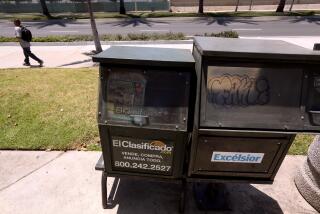A Net Gain in School : New computer network creates a virtual community where teachers and students can share ideas, resources and research. : NEXT L.A. / A Look at issues, people and ideas helping to shape the emerging metropolis
- Share via
Picture a large, comfortable room where teachers enthusiastically discuss the Los Angeles River as a real-world laboratory for lessons in biology, botany and the environment.
Students are there too, sharing data they’ve gathered on the river’s plants and animals.
Those in the room come and go, stepping out briefly to retrieve a book or get a drink of water. New participants--some novices, some experts invited to offer help--also drop by.
Now think of all of this taking place in cyberspace, a few keystrokes away from the computer screens of hundreds or even thousands of teachers, students and parents.
Such scenes are beginning to happen on the Los Angeles Learning Community Network, a new computer network that is attracting a rapidly growing cadre of educators across the county.
Resulting from a collaboration between the Los Angeles Educational Partnership, a nonprofit education improvement fund, and the Los Angeles County Office of Education, the network’s aim is to create a virtual community where teachers and students can share ideas, resources and research. Financial support comes from foundations, corporate donations and universities.
The network provides subscribers countywide with a low-cost portal ($49 a year) free of toll charges to the vast world of the Internet and its array of databanks, news and discussion groups, and the World Wide Web, with its myriad sources of videos, graphics and sound.
*
In addition, the network is an interactive, on-line source of lesson ideas, classroom tips and professional support for teachers.
For example, a Manhattan Beach third-grade teacher planning an oceanography unit could click through a series of menus to learn about a program at the Cabrillo Marine Aquarium in San Pedro that sends experts to classrooms for hands-on demonstrations. Or the teacher could tap into a Venice-based program focusing solely on whales.
Because teachers were involved in the network’s design, it is geared to their needs. They can get detailed sample lessons, for example, on topics such as light, measurement of angles, and longitude and latitude. Math teachers can find lesson plans already field-tested by peers, such as how to use Popsicle sticks and flash cards to help students review algebraic equations.
The designers of the system say the network’s regularly updated professional support listings and the sample lesson plans set it apart from similar educational ventures around the country. Another element of the network that makes it stand out is the emphasis placed on training its users.
Andy Dunau, the network’s director, said it provides access, substance and training. And all three, he said, are essential.
“We’re not just pushing Internet capacity, we’re working with them to help them feel successful,” Dunau said. And to do that, he said, teachers must be shown specifically how the network will benefit them in the classroom.
*
A teacher putting together a unit on earthquakes, for example, could see posted on the network the Internet address for students to find the magnitude and damage caused by quakes around the globe. Another network user has posted the Internet address of a Griffith Observatory astronomer who is willing to answer technical questions.
Once teachers have tapped into such resources they will see the network as a tool, not a toy. “Somewhere along the line it will become vital to them, but until it does they won’t use it,” Dunau said.
About 550 teachers have signed up for network accounts and more are being trained. And students and teachers are reaping the benefits. A group of third- and fourth-graders at Elizabeth Street Learning Center in Cudahy are researching Native American customs using the network’s Internet access, communicating with students living on reservations as well as with specialized museums.
The staff of the student newspaper at Foshay Learning Center in the Crenshaw area is getting tips from the work of peers at other schools in the country who have posted their work on the World Wide Web.
*
After meeting at a training session for the network, a group of math teachers was inspired to work via computer on a project exploring the intriguing mosaic tile-like patterns known as tessellations that result from mathematical equations. For now, however, the network’s growth is limited by the fact that relatively few schools and teachers have the upgraded computers and in-class telephone lines needed to gain full access. But its designers say the network shows how sophisticated telecommunications may shape the education of tomorrow. And by demonstrating that, the network may well add to the momentum of investment in educational technology.
“It’s not anywhere near what it can be and will be,” said John Lenhardt, the technology coordinator and lead teacher at Richard Henry Dana Middle School in San Pedro. “The growth potential in this I don’t think we have even imagined yet.”
Membership is not required to visit the Los Angeles Learning Community Network home page on the World Wide Web at https://laedu.lalc.k12.ca.us:70/0 /www/homepage.html.
More to Read
Sign up for Essential California
The most important California stories and recommendations in your inbox every morning.
You may occasionally receive promotional content from the Los Angeles Times.













